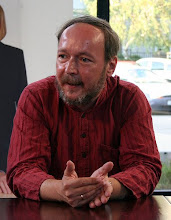
Late at night on 1st June I shall arrive at Hyderabad. Here follows a brief introduction to this wonderful city. (From http://www.hyderabad.co.uk/introduction.htm)
Introduction to Hyderabad
The capital of the state of Andhra Pradesh, Hyderabad is the fifth largest city in India with an ancient civilisation and culture. Attached to the city is its twin , Secunderbad, which is part of Hyderabad. The twin cities of Hyderabad and Secunderbad are separated by the Husain Sagar, an artificial lake constructed during the time of Ibrahim Quli Qutb Shah Wali in 1562 A.D.
The city is nearly 400 years old and is noted for its natural beauty, mosques and minarets, bazaars and bridges, hills and lakes. It is perched on the top of the Deccan Plateau, 1776ft., above sea level, and sprawls over an area of 100 Sq. miles.
A multitude of influences have shaped the character of the city. Its palaces and buildings, houses and tenements, gardens and streets have a history and an architectural individuality of their own, which makes Hyderabad a city of enchantment.
Hyderabad was founded on the River Musi five miles east of Golconda, in 1591-92 by Muhammad Quli Qutb Shah. In the 16th century the city grew spontaneously to accommodate the surplus population of Golconda, which was the capital of the Qutb Shahi rulers. Many buildings sprang up along the River Musi. Gradually the city grew.
The Qutb Shahi dynasty founded the Kingdom of Golconda, one of the five kingdoms that emerged after the break up of the Bahamani Kingdom. The Qutb Shahis ruled the Deccan for almost 171 years. All the seven rulers were patrons of learning and were great builders. They contributed to the growth and development of Indo-Persian and Indo-Islamic literature and culture in Hyderabad. During the Qutb Shahi reign Golconda became one of the leading markets in the world of diamonds, pearls, steel for arms, and also printed fabric.
The glory of the Golconda kingdom ended in 1687, after a valiant struggle. Aurangzeb, the last great Mughal ruler, captured Golconda after a siege that lasted eight months. Abul Hasan Tana Shah, the last king of Golconda, was imprisoned at Daulatabad, where he died after twelve years in captivity.
With the conquest of the Deccan and the South, Aurangzeb succeeded in expanding the Mughal Empire to cover the entire sub-continent. However, after his death in 1707, the Empire rapidly declined.
At that time , the Deccan was administered by a Subedar or viceroy of the Mughal Emperor. Mir Quamaruddin, the Governor of the Deccan, who bore the title of Nizam-ul-Mulk Feroze Jung Asif Jah, declared his independence from Mughal rule in 1724. He thus became the first Nizam and the founder of the Asif Jahi dynasty.
Asif Jah I continued to maintain Aruangabad, which had been founded by the Mughal rulers as the capital of his new state. In 1769, Nizam Ali Khan Asif Jah II, shifted the capital to Hyderabad. The seven Nizam's of the Asif Jahi dynasty ruled the Deccan for nearly 224 years, right up to 1948.
During the Asif Jahi period, Persian, Urdu, Telgu and Marathi developed simultaneously. The highest official positions were given to deserving persons irrespective of their religion. Persian was the official language up to 1893 and then Urdu up to 1948.
When the British and the French spread their hold over the country, the Nizam soon won their friendship without bequeathing his power. The title "Faithful. Ally of the British Government" was bestowed on Nizam VII. The British stationed a Resident at Hyderabad, but the state continued to be ruled by the Nizam.
The rule of the seven Nizam's saw the growth of Hyderabad both culturally and economically. Huge reservoirs, like the Nizam Sagar, Tungabadra, Osman Sagar, Himayath Sagar, and others were built. Survey work on Nagarjuna Sagar had also begun during this time.
Hyderabad, under the Nizam's, was the largest princely state in India. Area wise it was as big as England and Scotland put together. The State had its own currency, mint, railways, and postal system. There was no income tax.
Soon after India gained independence, Hyderabad State merged with the Union of India. On November 1, 1956 the map of India was redrawn into linguistic states, and Hyderabad became the capital of Andhra Pradesh.
Extracted from "Hyderabad, A City in History" by Raza Alikhan

No comments:
Post a Comment